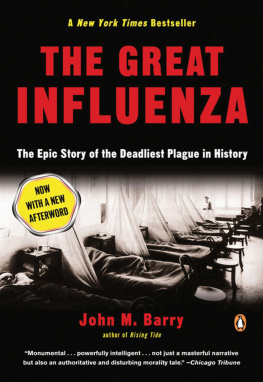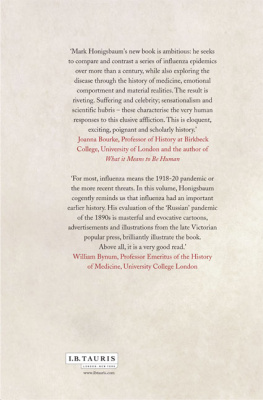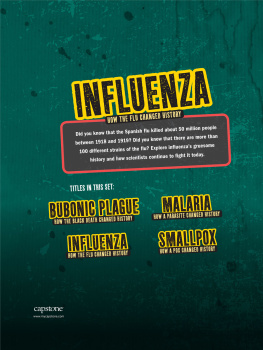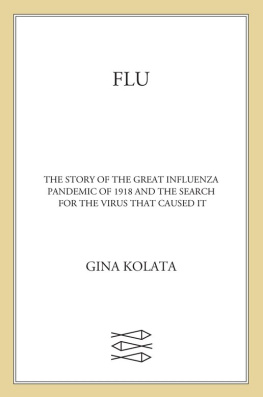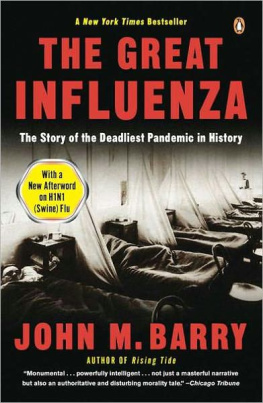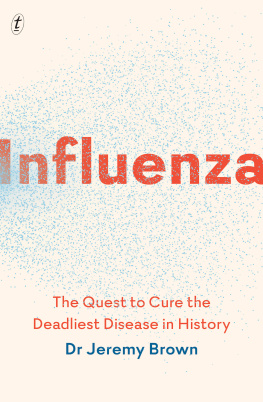THE GREAT INFLUENZA

ALSO BY JOHN M. BARRY
Rising Tide: The Great Mississippi Flood of 1927 and How It Changed America
Power Plays: Politics, Football, and Other Blood Sports
The Transformed Cell: Unlocking the Mysteries of Cancer (with Steven Rosenberg)
The Ambition and the Power: A True Story of Washington
THE GREAT INFLUENZA
The Epic Story of the Deadliest Plague in History
JOHN M. BARRY
VIKING
VIKING
Published by the Penguin Group
Penguin Group (USA) Inc., 375 Hudson Street, New York, New York 10014, U.S.A.
Penguin Books Ltd, 80 Strand, London WC2R 0RL, England
Penguin Books Australia Ltd, 250 Camberwell Road, Camberwell, Victoria 3124, Australia
Penguin Books Canada Ltd, 10 Alcorn Avenue, Toronto, Ontario, Canada M4V 3B2
Penguin Books India (P) Ltd, 11 Community Centre, Panchsheel Park, New Delhi - 110 017, India
Penguin Books (N.Z.) Ltd, Cnr Rosedale and Airborne Roads, Albany, Auckland, New Zealand
Penguin Books (South Africa) (Pty) Ltd, 24 Sturdee Avenue, Rosebank, Johannesburg 2196, South Africa
Penguin Books Ltd, Registered Offices: 80 Strand, London WC2R 0RL, England
Copyright * John M. Barry, 2004
All rights reserved
Photograph credits appear on .
LIBRARY OF CONGRESS CATALOGING-IN-PUBLICATION DATA
Barry, John M.
The great influenza: the epic story of the deadliest plague in history / John M. Barry.
p. cm.
Includes bibliographical references.
ISBN: 1-101-20097-9
1. Influenza (History (20th century. I. Title.
RC150.4.B37 2004
614.5'18'09041 (dc22 2003057646
Without limiting the rights under copyright reserved above, no part of this publication may be reproduced, stored in or introduced into a retrieval system, or transmitted, in any form or by any means (electronic, mechanical, photocopying, recording or otherwise), without the prior written permission of both the copyright owner and the above publisher of this book.
To my darling Anne
and to the spirit that was Paul Lewis
Contents
THE GREAT INFLUENZA
PROLOGUE
T HE G REAT W AR had brought Paul Lewis into the navy in 1918 as a lieutenant commander, but he never seemed quite at ease when in his uniform. It never seemed to fit quite right, or to sit quite right, and he was often flustered and failed to respond properly when sailors saluted him.
Yet he was every bit a warrior, and he hunted death.
When he found it he confronted it, challenged it, tried to pin it in place like a lepidopterist pinning down a butterfly, so he could then dissect it piece by piece, analyze it, and find a way to confound it. He did so often enough that the risks he took became routine.
Still, death had never appeared to him as it did now, in mid-September 1918. Row after row of men confronted him in the hospital ward, many of them bloody and dying in some new and awful way.
He had been called here to solve a mystery that dumbfounded the clinicians. For Lewis was a scientist. Although a physician he had never practiced on a patient. Instead, a member of the very first generation of American medical scientists, he had spent his life in the laboratory. He had already built an extraordinary career, an international reputation, and he was still young enough to be seen as just coming into his prime.
A decade earlier, working with his mentor at the Rockefeller Institute in New York City, he had proved that a virus caused polio, a discovery still considered a landmark achievement in the history of virology. He had then developed a vaccine that protected monkeys from polio with nearly 100 percent effectiveness.
That and other successes had won him the position of founding head of the Henry Phipps Institute, a research institute associated with the University of Pennsylvania, and in 1917 he had been chosen for the great honor of giving the annual Harvey Lecture. It seemed only the first of many honors that would come his way. Today, the children of two prominent scientists who knew him then and who crossed paths with many Nobel laureates say their fathers each told them that Lewis was the smartest man they had ever met.
The clinicians now looked to him to explain the violent symptoms these sailors presented. The blood that covered so many of them did not come from wounds, at least not from steel or explosives that had torn away limbs. Most of the blood had come from nosebleeds. A few sailors had coughed the blood up. Others had bled from their ears. Some coughed so hard that autopsies would later show they had torn apart abdominal muscles and rib cartilage. And many of the men writhed in agony or delirium; nearly all those able to communicate complained of headache, as if someone were hammering a wedge into their skulls just behind the eyes, and body aches so intense they felt like bones breaking. A few were vomiting. Finally the skin of some of the sailors had turned unusual colors; some showed just a tinge of blue around their lips or fingertips, but a few looked so dark one could not tell easily if they were Caucasian or Negro. They looked almost black.
Only once had Lewis seen a disease that in any way resembled this. Two months earlier, members of the crew of a British ship had been taken by ambulance from a sealed dock to another Philadelphia hospital and placed in isolation. There many of that crew had died. At autopsy their lungs had resembled those of men who had died from poison gas or pneumonic plague, a more virulent form of bubonic plague.
Whatever those crewmen had had, it had not spread. No one else had gotten sick.
But the men in the wards now not only puzzled Lewis. They had to have chilled him with fear also, fear both for himself and and for what this disease could do. For whatever was attacking these sailors was not only spreading, it was spreading explosively.
And it was spreading despite a well-planned, concerted effort to contain it. This same disease had erupted ten days earlier at a navy facility in Boston. Lieutenant Commander Milton Rosenau at the Chelsea Naval Hospital there had certainly communicated to Lewis, whom he knew well, about it. Rosenau too was a scientist who had chosen to leave a Harvard professorship for the navy when the United States entered the war, and his textbook on public health was called 'The Bible' by both army and navy military doctors.
Philadelphia navy authorities had taken Rosenau's warnings seriously, especially since a detachment of sailors had just arrived from Boston, and they had made preparations to isolate any ill sailors should an outbreak occur. They had been confident that isolation would control it.
Yet four days after that Boston detachment arrived, nineteen sailors in Philadelphia were hospitalized with what looked like the same disease. Despite their immediate isolation and that of everyone with whom they had had contact, eighty-seven sailors were hospitalized the next day. They and their contacts were again isolated. But two days later, six hundred men were hospitalized with this strange disease. The hospital ran out of empty beds, and hospital staff began falling ill. The navy then began sending hundreds more sick sailors to a civilian hospital. And sailors and civilian workers were moving constantly between the city and navy facilities, as they had in Boston. Meanwhile, personnel from Boston, and now Philadelphia, had been and were being sent throughout the country as well.
That had to chill Lewis, too.
Lewis had visited the first patients, taken blood, urine, and sputum samples, done nasal washings, and swabbed their throats. Then he had come back again to repeat the process of collecting samples and to study the symptoms for any further clues. In his laboratory he and everyone under him poured their energies into growing and identifying whatever pathogen was making the men sick. He needed to find the pathogen. He needed to find the cause of the disease. And even more he needed to make a curative serum or a preventive vaccine.
Next page

